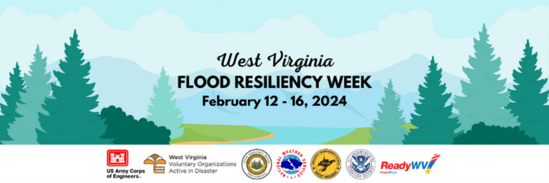|
Leaders from FEMA and the Maryland Department of Emergency Management visited Crisfield, Maryland to learn more about how the city is working with county, state, and other partners to reduce their flood risk. This work is part of FEMA’s Building Resilient Infrastructure and Communities (BRIC) Direct Technical Assistance (DTA) initiative. Subsequently, Crisfield applied for a BRIC grant to fund a number of mitigation projects. These projects will address severe flooding and build local resilience. The visit to Crisfield also came as part of FEMA’s “Year of Resilience,” which is a year-long initiative highlighting and promoting best practices in advancing equity, climate resilience, and readiness.
Watch the video and read more here.
The BRIC DTA initiative continues to advance. FEMA Region 3 received a record-breaking number of applications, representing a total of 20 communities and tribal nations. The region also received 167 BRIC and Flood Mitigation Assistance (FMA) grant applications, which is another record for the region!
- Take a Look! FEMA's "Year of Resilience" Highlights Crisfield, Maryland's Work to Reduce Flood Risk
- Announcements
- Featured Resource
- The Great Stabilizer: The Humble Sand Dune
- Pennsylvania Levee Receives Maximum Funding to Enhance Protection of Community and Residents
- Upcoming Coffee Break Webinars
- Maryland Program Advances Real-Time Weather Data
- Boosting Flood Awareness Across the Region
- Tribal Leaders, FEMA Region 3 Meet for First Emergency Management Overview
- Spotlight: Engaging Young Minds with Victor Ukpolo, Washington, DC Department of Energy and Environment (DOEE)
- Upcoming Events
 |
|
Announcements |
-
Searching for Mitigation Ideas? Take a peek at FEMA's Updated Mitigation Action Portfolio: FEMA made updates to its Mitigation Action Portfolio, which highlights innovative projects for a number of natural hazards. These projects are eligible under FEMA’s Hazard Mitigation Assistance (HMA) programs. The portfolio includes FEMA’s Community Lifelines* along with case studies. It also offers resources to help people apply for HMA grants.
*Note: The updated portfolio includes seven Community Lifelines. FEMA now has eight Community Lifelines.
-
Taking Care of Our Caregivers! FEMA and the Rosalynn Carter Institute's New Disaster Preparedness Guide for Caregivers: FEMA teamed up with the Rosalynn Carter Institute (RCI) for Caregivers to release a new preparedness guide, designed to help caregivers prepare for disasters and protect their loved ones. An estimated 53 million people in the United States provide care for someone ill, disabled, or older. The guide focuses on three essential steps—assessing needs, engaging a support network, and creating a plan. FEMA and RCI invite caregivers, care recipients and the public to access and disseminate this vital resource, which can be found on ready.gov.
 |
|
Featured Resource |
Tune in to “Before, During & After,” FEMA’s podcast for emergency managers! A recent episode, “Including People with Disabilities in Disaster Operations,” highlights a new version of training course IS-368. Released by FEMA’s Office of Disability Integration and Coordination, the course provides an introductory overview of information and strategies to include people with disabilities during mitigation, preparedness, and recovery efforts.
This episode is just one of many that shares insights into where emergency management is headed in preparing for the threats of tomorrow, and how everyone has a role in keeping communities safe from disasters. Podcast host Mark Peterson covers FEMA’s work in implementing its strategic plan, as well as recent disaster recovery efforts and resources available to better prepare for future risks.
Source: Delaware Department of Natural Resources and Environmental Control
Sand dunes along Delaware’s beaches are vital natural resources. These natural barriers are the first line of defense for those who live near the shore and protect against coastal flooding and storms. Dunes also act as sand storage areas; they supply sand to beaches that have eroded after storm events. Almost every spring since 1990, volunteers have taken part in an annual beach grass planting to help stabilize Delaware’s sand dunes. Dunes are subject to damage or erosion from wave action, vehicles, and people.
Each March, volunteers plant more than 5 million stems of Cape American beach grass to protect the dunes. Beach grass can survive in the face of high salinity, extreme heat, and changes in water supply. Volunteers plant two stems of beach grass per hole in rows about 12 to 18 inches apart. These staggered rows are meant to control against wind erosion. Beach grasses help to trap sand blown by the wind. Trapped sand can create new dunes and expand current ones. Aside from protection from storms, dunes along Delaware’s coast also protect people and property from rising sea levels brought on by climate change and land subsidence.
Learn more about the importance of sand dunes and beach grass planting in Delaware here.
South Williamsport, a borough in Lycoming County, Pennsylvania, has been awarded a $500,000 grant for a levee improvement project. The funding will be used to build and repair cross pipes on the Williamsport South Levee, as the pipes have become corroded over time.
These repairs are part of a process to help the Greater Williamsport levee system meet FEMA compliance. They are also meant to help reduce flood insurance costs for residents. Right now, around $15 million has been approved from federal and state sources for a handful of construction projects. The Lycoming County Planning Department reported that the levee system protects roughly $5 billion in real estate assets in the area.
The levee is on the right bank of the West Branch Susquehanna River and was last assessed in June 2019. It consists of a 2.1-mile embankment, 0.2 miles of floodwall, three pumping stations, and 25 drainage structures. State Representative Jamie Flick (R-83) noted that the levee protects around 644 structures and around 60% of the borough’s land area.
The Commonwealth Financing Authority, an independent agency of the Department of Community and Economic Development, approved the grant. Funding was provided through the Flood Mitigation Program (FMP), which is funded by the Marcellus Legacy Fund. This fund was founded to collect and direct a portion of natural gas impact fees to support local environmental and conservation work. The maximum allowable award for the FMP is $500,000, with a required 15% match.

Grab a cup of joe and join us to hear about mitigation best practices!
FEMA Region 3’s popular webinar series welcomes everyone interested in reducing risk in their community for a bit of inspiration. These hour-long “Coffee Breaks” are held every other month and explore a wide range of best practices related to planning and building community resilience. The webinars also highlight strategies at the federal, regional, state, and local levels to reduce risks from natural hazards in the region that can be incorporated into hazard mitigation plans and other efforts.
Coffee Breaks are open to anyone involved with hazard mitigation, resilience, or risk reduction planning. Attendees often include community planners, emergency and floodplain managers, Geographic Information Systems (GIS) technicians, government officials, contractors, and professionals from nongovernmental organizations and the private sector.
To sign up, visit the FEMA Region 3 Coffee Breaks Eventbrite Page.
Upcoming Coffee Breaks:
-
May 29: Ensuring Equitable Mitigation Through Hazard Mitigation Planning
-
July 24: Planning for a Changing Climate
-
September 4: Historic Preservation Strategies in Hazard Mitigation Planning
-
November 6: Reviewing FEMA’s Tools and Resources
You can also find a list of previous Coffee Breaks at the link above, some of which you can view on FEMA’s YouTube channel. Please note that you cannot receive professional accreditation for viewing previous Coffee Breaks.
We want to hear from you! Do you have an idea for an upcoming Coffee Break? Would you or someone you know like to present on a mitigation topic? Send us an email at fema-r3-hm-planning@fema.dhs.gov with your Coffee Beak ideas and suggestions.
*Webinar topics, dates, and descriptions are subject to change.
|
On February 7, the University of Maryland Department of Atmospheric and Ocean Science and the Maryland Department of Emergency Management raised a real-time weather transmission tower. This is the first Mesonet tower in Prince George’s County; there are six others across the state. Part of the Maryland Mesonet program, the towers transmit live weather data back to students in College Park, as well as the National Weather Service and emergency management personnel.
The program’s mission is to “design, build, and operate a network of high-quality, closely spaced, rapid-sampling weather monitoring and data collection systems across the state.” The goal is to boost emergency preparedness, aid disaster response and recovery, and make local weather forecasting more accurate.
The towers are spaced about 10 miles apart and measure air temperature, atmospheric pressure, relative humidity, wind speed and direction, solar radiation, rainfall, snow depth, and soil moisture and temperature. The towers take measurements at five depths, at 1-minute intervals. Anyone can access the towers’ live feeds via the Maryland Mesonet website.
The program will use rapid sampling and transmission to fill gaps in the federal observing system. This micro network could also give emergency management personnel and meteorologists more lead time when they look at severe weather. Maryland is no stranger to sudden severe weather; the flash flood in Ellicott City in 2018 is only one example. Just a few minutes of warning could make a big difference for affected communities.
West Virginia, Virginia, Pennsylvania and Washington, D.C. have each held or announced flood awareness weeks. These are meant to teach residents about flood risks and inspire them to act. Spring and summer are timely seasons for outreach on flooding with spring rains arriving and people getting ready for hurricane season.
West Virginia Governor Jim Justice proclaimed February 12 through 16 as Flood Resiliency Week to recognize the impact that floods have on communities. Throughout the week, the West Virginia Emergency Management Division posted information, tools, and resources on social media. Topics covered included emergency alerts; floodplain mapping; homeowner mitigation tips; individual emergency action plans; flood insurance; evacuations; permitting; stormwater management; dam safety; and floodplain management.
 Source: West Virginia Emergency Management Division
Virginia Governor Glenn Youngkin proclaimed March 10 through 16 as Virginia’s Flood Awareness Week. He stressed that this is a great time to prepare for flooding. The Virginia Department of Conservation and Recreation shared information on flood awareness, the Virginia Flood Risk Information System, and outreach on its website. Communities and other stakeholders may use those outreach resources to promote Flood Awareness Week and the importance of flood preparedness. They include media toolkits and templates from FEMA. They also include news releases, fliers, articles, and web graphics produced by the state.
Pennsylvania also hosted its Flood Awareness Week on March 18-22. Additionally, partners in Washington, D.C. are gearing up to host the District’s Flood Awareness Week from June 10-14.
 Source: Virginia Department of Conservation and Recreation
This March, tribal leaders joined FEMA for the first Emergency Management Overview in Region 3. These leaders came from the Chickahominy Indian Tribe, Chickahominy Indians-Eastern Division, Inc., Monacan Indian Nation, Inc., and Nansemond Indian Nation. The meeting stressed the value of tribal emergency training.
Tribes are a key part of the nation’s emergency management team. We must keep their unique cultural needs in mind when we support their planning, response, and recovery efforts. Meeting to discuss training is one way to make sure tribes can use FEMA’s tools and resources.

In this issue of the Resilience Report, we connected with Victor Ukpolo, Environmental Protection Specialist at DOEE.
At last year's Region 3 National Flood Insurance Program (NFIP)/State Hazard Mitigation Officer (SHMO) Conference, you presented on the Flood Ready Youth Workshop. What have you seen come from those offerings?
The Flood Ready Youth Workshop is an after-school program. It is designed to make flood risk awareness and language a part of our youth's lives. DOEE partners with the Anacostia Parks Community Collaborative and After-School All-Stars. They take the lead in finding schools and students to participate. This program uses dynamic and interactive methods to teach students about topics such as watershed management. We have also inspired students to expand their creativity through projects that they can share in their communities. These projects have included designing t-shirts and creating social media to promote flood awareness.
In your work with DOEE, what are your beliefs about outreach and engagement?
As a government agency, a key part of building partnerships is bringing resources to the table. This is especially the case with community organizations that may work with limited budgets. It is so helpful to be able to add to what they are trying to accomplish. Aside from funding, we have also created physical materials for our community partners to use in their own programming, such as maps and posters. We are gathering data to track our impact with these engagements on flood risk awareness.
|
What do you think of the future of environmental protection?
I am inspired by the growth in mitigation practices that are based in equity. There is work being done to boost the collective sense of historic inequities in planning. This way, we can pinpoint where we need to adjust. This does not just include how we look at grant-making programs. It also includes how we enforce our policies and regulations. Strategic discussions with community members are a vital part of ongoing work. The goal is to create the best and most equitable solutions for everyone.
Learn more about DOEE’s work in community outreach here.
*Note: At the time of publication, Victor Ukpolo had moved on from his position at DOEE.
Image source: Victor Ukpolo
Virtual
4/19/2024: University of Delaware Grant Assistance Program Training Series: Grant Research
4/23/2024: FEMA Grants Programs Directorate (GPD) Standard Procurement Under Grants Training
4/26/2024: University of Delaware Grant Assistance Program Training Series: Understanding Grant Details
5/2/2024: CRS Manual Hacks – Flood Hazard Mapping – Activity 410
5/3/2024: University of Delaware Grant Assistance Program Training Series: Writing Project Narratives
5/8/2024 – 5/10/2024: American Planning Association’s 2024 National Planning Conference (Virtual Option)
5/10/2024: University of Delaware Grant Assistance Program Training Series: Budgets
5/14/2024: FEMA GPD Standard Procurement Under Grants Training – Mitigation Grants
5/14/2024 – 5/15/2024: Fundamentals of Floodplain Management Webinar
5/17/2024: University of Delaware Grant Assistance Program Training Series: Application Management and Submission
5/24/2024: University of Delaware Grant Assistance Program Training Series: Closeout, Compliance, and Reporting
5/29/2024: FEMA Region 3 Coffee Break: Ensuring Equitable Outcomes Through Hazard Mitigation Planning
5/30/2024: FEMA GPD Standard Procurement Under Grants Training
6/11/2024: FEMA GPD Prepare Before a Disaster Training
6/20/2024: FEMA GPD Standard Procurement Under Grants Training
6/25/2024 – 6/27/2024: Planning Effective Projects for Coastal Communities Workshop
7/24/2024: FEMA Region 3 Coffee Break: Planning for a Changing Climate
8/1/2024: CRS Manual Hacks – Higher Regulatory Standards – Activity 430
9/4/2024: FEMA Region 3 Coffee Break: Historic Preservation Strategies in Hazard Mitigation Planning
9/5/2024: CRS Manual Hacks – Flood Data Maintenance – Activity 440
11/6/2024: FEMA Region 3 Coffee Break: Reviewing FEMA’s Tools and Resources
In Person
4/22/2024 – 4/25/2024: FEMA EMI E0273: Managing Floodplain Development through the NFIP, Emmitsburg, MD
4/25/2024: Virginia Water Environment Association Annual Stormwater Seminar & Vendor Showcase, Richmond, VA
5/13/2024 – 5/15/2024: FEMA EMI E2461: Advanced Building Science Series I: Flood Mitigation, Emmitsburg, MD
5/16/2024 – 5/17/2024: FEMA EMI E2462: Advanced Building Science Series I: Wind Mitigation, Emmitsburg, MD
5/20/2024 – 5/21/2024: FEMA EMI E0103: Planning: Emergency Operations, Emmitsburg, MD
6/23/2024 – 6/27/2024: 2024 ASFPM Conference, Salt Lake City, Utah
6/24/2024 – 6/26/2024: FEMA EMI E0705: Fundamentals of Grants Management, Emmitsburg, MD
10/20/2024 – 10/22/2024: Keystone Emergency Management Association 7th Annual Pennsylvania Emergency Preparedness and Homeland Security Conference, Altoona, PA
|